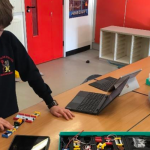What is Child Development?
Child development is a process by which children build their physical development, social and emotional functioning, and cognitive capacity. Starting from the very basics, such as being able to recognize faces or making sounds, children learn how to make sense of their emotions and to struct complex connections in the world. Of course, a child’s brain development is also crucial to child development because cognitive, emotional, and executive skills depend heavily on brain functions.
The majority of children are observed to acquire certain abilities at almost the same ages unless disturbed by developmental disorders. Based on this, the experts divided child development into five stages. They also set specific abilities such as being able to walk or comprehend complex sentences as child development milestones. Children are expected to reach those milestones by certain ages and stages of child development.
Newborn Stage
The newborn stage is the first 2 months of life. At this stage of child development, newborns can react to sounds, watch people as they move, and calm down when spoken to or picked up.
The environment in which a child develops before and soon after birth strongly influences child development. For this reason, the newborn stage is considered to be the most important age for child development. So, it is of utmost importance for child development that the parents should cultivate a close relationship with their newborn baby through skin-to-skin contact. Additionally, newborns require a lot of sleep as the child’s physical development and brain development proceed rapidly.
Infant Stage
Children between 2 months and 1 year old are considered in their infant stage. At this stage, the physical child development continues rapidly: they start crawling around, sitting without support, and picking up objects. Also, children in this stage often put their hands and feet and other objects in their mouths.
Infants are capable of recognizing familiar faces and responding to their names. They try to communicate through gestures and imitating the sounds they hear. So, it is crucial for the parents to constantly talk to the children at this stage of child development.
Toddler Stage
The toddler stage covers the period between the first 1 year and 3 years of life. This age range is considered the fastest of the child development stages because toddlers physically grow at a drastic pace and become more and more adapted to social life. They are expected to be able to walk without any support, drink from an open cup (spilling only occasionally), and use a spoon and a fork by themselves during this period gradually.
In addition to physical child development, this stage comes forward as a period in which a child develops emotionally and socially. Socialising starts at this stage; children tend to move away from their parents but make sure they are present. They usually try to connect with their peers and join other children by copying the way they play with toys or each other. They show affection, notice when others are hurt or upset, and look at their parents’ faces to see how they react to a new situation. In short, they learn how to identify and process their emotions at this developmental stage.
Preschool Stage
Children between 3 and 5 years old are referred to as preschool children. Physical child development heightens at this stage, and children’s motor skills become refined: they can throw and catch a ball, run, jump, and dress themselves.
Their social and cognitive skills also improve during this stage as they are introduced to a whole different world than their household. For example, they can differentiate between the wanted and unwanted behavior at certain places and change behavior based on where they are, such as libraries, playgrounds, and places of worship. Also, it is expected from a preschool child to be able to keep a conversation with more than three back and forth exchanges.
School-Age Stage
This stage of child development lasts between 6 and 17 years of age, which is the longest. During this stage, children advance their cognitive skills as they learn complex notions and various structures of knowledge at school. It’s more likely to improve short attention span at this stage of child development. This stage is also when children begin to form their own opinions and become independent.
Also, in terms of emotional capacity, they can identify complex emotions such as jealousy, love, hate, etc., and express their feelings through well-developed sentences and gestures. Children in this developmental stage are expected to be able to form meaningful friendships and connect with people on a social scale. They should maintain a regular sleep pattern, especially during this stage, because the effects of sleep on learning and physical child development as well as on emotional development are quite remarkable.
What are Developmental Milestones for Kids?
As explained above, there are five main stages of child development; each stage has several developmental milestones associated with it. Child developmental milestones can be defined as particular abilities a child is expected to acquire by a certain age group, such as walking for the first time, developing a sense of empathy, and many more.
The Centers for Disease Control and Prevention (CDC) classifies child development milestones into the following four categories:
- Social/Emotional Milestones: These milestones refer to the development of a child’s emotional capacity. It concerns whether a child shows several facial expressions, tries to understand how to react to new situations, notices others’ feelings, and tries to comfort them if they are hurt or upset.
- Cognitive Milestones: Cognitive milestones are based on learning, thinking, and problem-solving skills children achieve according to their ages. These include identifying colors, looking for objects out of sight, figuring out how to open a lid, or showing simple problem-solving skills like standing on a stool to reach something.
The benefits of science activities for kids and reading to/with them help children achieve those cognitive milestones and improve kids’ analytical thinking.
- Language/Communication Milestones: This category concerns communication skills and how children use language to express themselves. Making sounds other than crying, imitating the way others name things, reaching for objects they want, and enhancing vocabulary can be seen as examples.
- Movement/Physical Development Milestones: Physical child development is about how children grow according to their ages and use motor skills and executive functions. For example: holding their head steady, standing on themselves, walking, drinking from a cup without spilling, using a spoon and fork properly, etc.
New CDC Guidelines for Child Development Monitoring
To help track a child’s development stages and address possible developmental disabilities, The Centers for Disease Control and Prevention (CDC) advises every child to get developmental screenings in their 9th, 18th, and 30th months. Additionally, the CDC and the American Academy of Pediatrics (AAP) updated their guidelines for child developmental milestone monitoring for the first time since 2004. This guideline aims to improve the early identification of children with autism and other developmental disabilities so that children and families can get help as early as possible.
The CDC and AAP also included new milestones and open-ended questions. All the milestones reflect what 75% of children are expected to achieve by certain ages with this revision. It was only 50% in the previous guideline. So, if a child has not met a milestone, it is more likely to point to a developmental issue.
8 Positive Parenting Tips for Healthy Child Development
A child is influenced heavily by any kind of stress or uneasiness as well as positive factors. In that light, the impact of parenting styles on child development is also critical. Here are some tips on healthy development for children!
- Showing Warmth and Affection: One of the most important factors in child development is parents’ unconditional love. So, show them your love through affectionate gestures such as hugs, praises, and acknowledgments of their success. Make sure they know that even if they do something wrong, you believe they will learn from their mistake, and your love is there no matter what.
- Communicating with Your Child: Healthy child development depends heavily on a healthy relationship between the parents and the child. The key element for this bond is communication. During the early stages of child development, talking to them enhances their language and cognitive abilities and strengthens the bond at later stages.
Experts also claim that responding to children predictably in any scenario is important so that you won’t cause any confusion and stress, adversely affecting child development.
- Setting Routines and Limits: Setting routines in a household helps children form a sense of stability in their lives which positively affects the child development stages. Additionally, setting limits on playing outside or snacks and managing screen time improve their sense of self-control. They learn how to use time effectively.
- Spending Quality Time Together: Children need to spend time with their parents. So, you might try creating quality time for your child. Painting, reading, playing games, and going on trips together are great activities to bond with your child. You can also do simple experiments at home to engage your kids in learning science.
- Giving Them a Sense of Responsibility: It is also important to establish a sense of responsibility in children from the early stages of child development. Problem-solving activities for kids and giving your children appropriate chores may be beneficial in building their sense of responsibility and problem-solving skills.
- Allowing Them to Make Mistakes: Removing all obstacles from a child’s way doesn’t help them at all. Parents might try allowing their children to make mistakes and find the right thing themselves before interfering with the child’s developmental stages. They can also use different learning styles to find what works best for them.
- Promoting Healthy Behaviors: You can urge your children to adopt healthy behaviors such as physical activities, eating healthy food, etc. Leading a healthy life influences child development directly!
- Being a Good Role Model: The kind of a person you are and the way you lead your life influence your child as well. Children tend to mimic their parents while they construct their identities. So, being a good role model for your child may be the most important thing in your child’s development.
What can you do to support your child’s development?
Child development can be a distressing process for many, but there are various ways to support your child’s development. You might want to consider the benefits of technology for children as the digital world evolves each day, and there are many positive effects of technology on child development.
The importance of STEM education in child development is also significant as it improves analytical thinking and cognitive skills. But STEM education doesn’t only advance child brain development; it also enhances emotional and social development. For example, analytical thinking helps children identify their emotions and react to new situations healthily. Art, as well, provides them with a space where they can process and express their emotions.
You can urge your kids in learning STEM with Twin to support your child’s development. In Twin App, various live shows, educational videos, and interactive games teach children about many subjects ranging from physics to coding. Additionally, children can experiment with hands-on activities through Twin kits: autonomous vehicle kits, coding kits, and robotic art kits.
Besides all, Twin App provides a monthly Skill Report based on your child’s activity in the app. The report includes your child’s monthly skill use, interest areas, subjects your child is good at, personalized activity recommendations, and many more. Check out our website to learn more about Twin App subscriptions and Twin kits!



